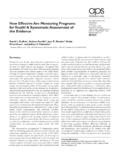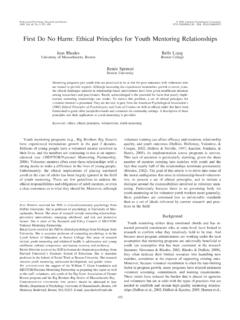Transcription of The Test of Time in School-Based Mentoring: The …
1 ORIGINAL PAPERThe Test of time in School-Based mentoring : The Roleof relationship duration and Re- matching on AcademicOutcomesJean B. Grossman Christian S. Chan Sarah E. O. Schwartz Jean E. RhodesPublished online: 6 April 2011 Society for Community Research and Action 2011 AbstractThe influence of match length and re-matchingon the effectiveness of School-Based mentoring was studiedin the context of a national, randomized study of 1,139youth in Big Brothers Big Sisters programs. The sampleincluded youth in grades four through nine from diverseracial and ethnic backgrounds.
2 At the end of the year,youth in intact relationships showed significant academicimprovement, while youth in matches that terminatedprematurely showed no impact. Those who were re-mat-ched after terminations showed negative impacts. Youth,mentor, and program characteristics associated with havingan intact match were examined. Youth with high levels ofbaseline stress and those matched with college studentmentors were likely to be in matches that terminated pre-maturely, while rejection-sensitive youth and mentors whohad previous mentoring experience were more likely to bein intact relationships.
3 Implications for research and prac-tice are Adolescence school -basedinterventionIntroductionScho ol- based mentoring (SBM) is the fastest-growing formof mentoring in the US, serving hundreds of thousands ofvulnerable students (MENTOR2006). Although a rarity15 years ago, more than half of mentoring programs partnerwith elementary, middle, and high schools to create men-toring programs that take place in schools (DuBois andKarcher2005). Whereas traditional community-basedmentoring (CBM) typically occurs in neighborhood settingsover the course of a calendar year, SBM mentoring typicallyoccurs in school settings over the course of an academicyear.
4 Moreover, mentors in SBM tend to be more demo-graphically diverse than those in CBM and to spend rela-tively more time working on academic goals (Herrera et ). Although recent random-assignment impact evalu-ations showed few statistically significant effects for thesamples as a whole (Bernstein et ; Herrera et ; Karcher2008; Wheeler et ), secondaryanalyses of these data suggest variability in effects acrossdifferent subgroups of youth (Herrera et ; Karcheret ; Schwartz et al., in press). These findingsunderscore the importance of identifying factors thataccount for variation in the effectiveness of SBM.
5 Thepresent study draws on data from a recent national evalu-ation of ten Big Brothers Big Sisters (BBBS) SBM agencies(Herrera et ) to examine whether, and under whatconditions, match length and re- matching are associatedwith differential effects on youth academic research has suggested that match length is animportant factor accounting for variability in CBM pro-gram effects. In fact, because duration tends to beJ. B. GrossmanPublic/Private Ventures, Philadelphia, PA, USAJ. B. GrossmanWoodrow Wilson school of Public and International Affairs,Princeton University, Princeton, NJ, USAC.
6 S. Chan S. E. O. Schwartz J. E. Rhodes (&)Department of Psychology, University of Massachusetts Boston,100 Morrissey Boulevard, Boston, MA 02125, USAe-mail: J Community Psychol (2012) 49:43 54 DOI with close relationships and strong programs,match length is one of best benchmarks of programeffectiveness (DuBois and Rhodes2006; Grossman andJohnson1999). In a re-analysis of data from a random-assignment study of the BBBS CBM programs, Grossmanand Rhodes (2002) found that effects of youth outcomesbecame progressively stronger as relationships persisted forlonger periods of time .
7 The largest benefits were evidentfor youth in relationships that lasted 1 year or longer. Bycontrast, youth in relationships that terminated in fewerthan 3 months showed declines in functioning relative tocontrols. Such trends remained, even after controlling forpotential confounding influences such as baseline charac-teristics of youth that could contribute to increased riskfor premature termination. Other investigations have alsohighlighted the importance of match length and consis-tency, as well as the negative consequences of early ter-minations (DuBois et ; Karcher2005; Slicker andPalmer1993; Spencer2006).
8 These patterns make sense when we consider the potentialcomplexities of youth mentoring processes (Spencer2006).In particular, mentoring is thought to rest on close interper-sonal connections and, in some cases, to influence youththrough changes in their approach to other relationships. Forexample, by providing care and support, mentors can chal-lenge negative views that youth may hold of themselves anddemonstrate that positive relationships with adults are pos-sible. In this way, a mentoring relationship can become a corrective experience for youth who have experiencedunsatisfactory relationships with parents or other caregivers(Hayes et ).
9 Likewise, by serving as a sounding boardand providing a model of effective behavior and communi-cation, mentors may help youth to better understand, express,and regulate their emotions (McDowell et ). Positivesocial-emotional experiences with mentors may generalize,enabling youth to interact with others more effectively. Insupport of this prediction, enduring mentoring relationshipshave been linked to significant improvements in youths perceptions of their relationships with parents, peers, andother adults (DuBois et ,b; Karcher2005; Rhodeset ,2005).
10 Unfortunately, many SBM programs are characterizedby relatively short matches. Recent evaluations haverevealed that the average length of SBM matches isapproximately 5 months (Bernstein et ; Herreraet ), compared with a 1-year average in CBMrelationships (Grossman and Tierney1998). Moreover, asmany as half of SBM relationships terminate prematurely(Bernstein et ; Herrera et ). To address thisproblem, program staff are increasingly re- matching youthwhen their mentoring relationships are troubled or prema-turely terminated (Keller2005).








